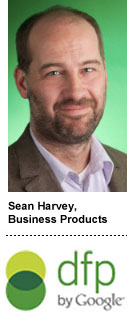 After years of courting the demand side with all sorts of tools aimed at marketers, small businesses and media buyers, Google is paying a little more attention to its publisher partners on the supply side. The latest offering is Audience Extension from DoubleClick For Publishers and was announced by Google’s Neal Mohan at yesterday’s Ad Trading Summit in London.
After years of courting the demand side with all sorts of tools aimed at marketers, small businesses and media buyers, Google is paying a little more attention to its publisher partners on the supply side. The latest offering is Audience Extension from DoubleClick For Publishers and was announced by Google’s Neal Mohan at yesterday’s Ad Trading Summit in London.
Google is pitching this as a completely new feature in the upgraded DFP. It will allow publishers to purchase third party inventory directly from DFP and bundle it with their owned & operated inventory. “The publisher will set the flight dates, targeting criteria and bid parameters at the DFP line item level and we will go out and automatically book the buyer campaign for them,” Sean Harvey, Business Products Manager for DFP, told AdExchanger.
It’s been about four years since Google acquired DoubleClick for $3.1 billion, as the search giant looked to conquer the display business. It’s also been about two years since Google replaced DoubleClick’s display ad serving system, DART, with DFP. That system has always come in two flavors: the main DFP, which is for the largest online publishers and is most closely modeled on the DART system; and DFP Small Business, which is a basic, no frills, free version for smaller content outlets.
“In DART, we had previously allowed publishers to push their first party audience segments into an AdX Buyer account, and a number of our publishers have had great success with this,” Harvey tells us. “But what we are announcing today is a completely new integration.”
As to whether the benefits of Audience Extension are primarily for larger publishers or smaller ones, Harvey says its intent does not rest on the size of the publisher. “A wide range of publishers have unique data sets that are valuable to advertisers even outside the context of their owned & operated inventory,” he says. “We expect these publishers will benefit tremendously from DFP Audience Extension. We’re also hearing from publishers focused on a particular city or metro area that audience extension allows them to scale up to 100 percent coverage of their target region and thus increase their appeal to advertisers.”
Although the attention to the supply side might seem to have something to do with Google’s absorption of yield optimizer AdMeld, which it acquired last year for $400 million, the road between Audience Extension and that part of the company is still separate, Harvey notes.
“AdMeld is about monetizing your own inventory by indirect means,” Harvey says. “This is about acting as a buyer, not a seller, and purchasing inventory on an auction basis using your unique data sets, just as trading desks do today. Purchased inventory is typically sold on a direct basis as part of larger campaigns. We are integrating DFP Audience Extension first with the DoubleClick Ad Exchange and soon with the next generation of [demand side platform] Invite Media, the DoubleClick Bid Manager.”
In terms of how far Audience Extension can go for publishers, it is not focused on mobile, but it can be used to purchase mobile impressions as well.
Elsewhere on Google’s publishing side, the company is naturally looking to expand its efforts around video ad dollars. Google and publisher-focused content syndication platform OneScreen are partnering within the DoubleClick and AdSense systems.
“By combining this advertising with OneScreen’s extensive library of content, publishers can now provide their audience with more content while generating real revenue,” says Rany Ng, Group Product Manager for Google video monetization.
“Video needs to be a meaningful revenue driver for publishers,” added Atul Patel, CEO and Founder of OneScreen. “Adding Google’s advertising capabilities with our syndication platform, publishers can now monetize their own video content or the content obtained through our connected producers and aggregators.”
OneScreen isn’t Google’s only helper, Ng noted.
“We’re partnering with all major online video platforms so that our publishers can take advantage of advanced video ad sales features in DFP and access advertiser demand sources on AdX. We’ve accelerated integrations of our new IMA3 SDK for Flash, HTML5, iOS, and Android to ensure publishers can easily display video ads in all environments, including mobile web and in-app.”
In other words, with Google’s share of U.S. display ad revenues expected to reach 16.5 percent by the end of this year, up from 13.8 percent in 2011 and 12.1 percent in 2010, according to eMarketer, the company isn’t merely content to let the money flow in. With Facebook ascendant, at least on the display front with the social network’s share of display expected to grow to an impressive 16.8 percent, Google can’t afford to leave any display dollars untapped or hard to get to.












